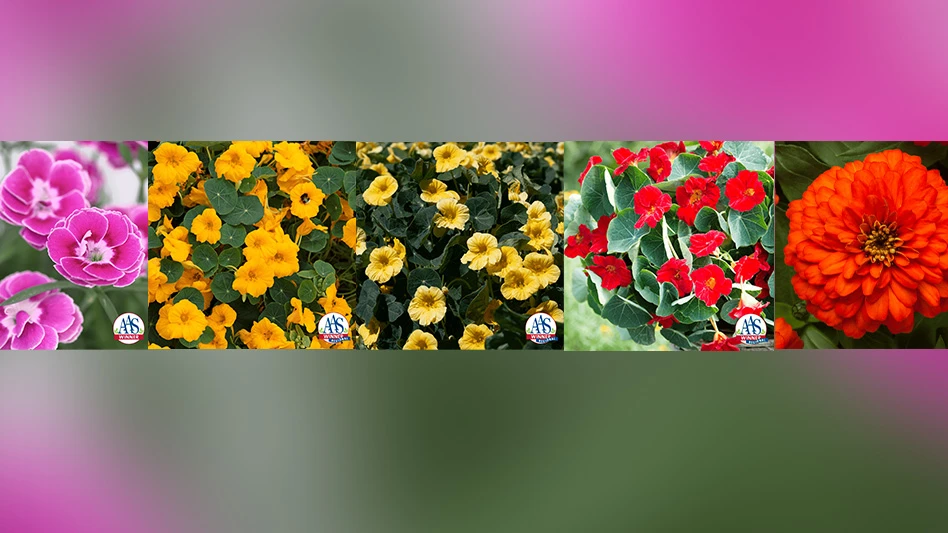
While some fall crops such as dusty miller (Senecio cineraria) and ornamental grasses are marketed primarily for their foliage and not their flowers, a majority of fall crops are grown for their flowers. Like many floriculture crops, daylength influences flowering for several fall crops — yet they don’t all have the same requirements. The aim of this article is to summarize the photoperiodic flowering requirements of the most popular fall greenhouse crops.
Garden mums and asters
An article on flower induction for fall crops would not be complete without talking about garden mum (Dendranthema × grandiflorum) and aster (Aster novi-belgii). Garden mums the most popular flowering fall crop, and asters are often included as part of the product mix. Like their close kin, the florist or pot mum, garden mums are short day plants. However, while short days (12 hours or less) are required for garden mums to flower, cool temperatures can also affect flower induction and cause premature budding in some cases. Asters also have a photoperiodic flowering response and require short days; however, they also require long days prior to short days in order to flower and are classified as a long-day/short-day (LD-SD) plant. While long days are provided to garden mums in order to sufficiently bulk up plants to an appropriate size, they are not required prior to short days in order to get crops into flower; asters must receive long days before short days in order to achieve flowering. In order to get the earliest crops of mums and asters into flower on time, it is often necessary to use either black cloth or black plastic to truncate the daylength and provide long nights (and short days).

Sunflower
In addition to being a popular summer cut flower, the large yellow flowers on sunflowers (Helianthus annuus) make them another popular potted fall crop. Most potted sunflower cultivars have a facultative short-day flowering response, where flowering will occur under non-inductive long days, but flowering will occur more quickly when plants are exposed to short days. Since potted sunflowers are most likely produced when the days are naturally long, using black cloth to provide short days in the greenhouse will help induce them to flower. If sunflower plugs are being grown to be transplanted into containers for finishing, the short days can be provided during propagation to induce them, reducing the amount of space under black cloth that is required. If no black cloth is provided, be sure to plant them earlier to account for the additional time to flower required as a result of growing under long days. Additionally, plan for PGR sprays to maintain target crop heights, as more nodes (and, therefore, internodes) will be formed under long days before buds are formed.
Rudbeckia
Rudbeckia, including R. hirta and R. fulgida, are some additional species in the Aster family that are popular as fall potted plants. However, in contrast to their brethren in the Asteraceae already mentioned, including garden mums, asters and sunflowers, rudbeckia have a long-day photoperiod response. This makes inducing flowering during the summer easy, as the days are naturally long. For crops growing in large containers, plants may need more bulking to achieve sufficient vegetative growth to fill-in containers, and providing short-days
Pansies and violas
In addition to being popular spring annuals, pansies (Viola × wittrockiana) and violas (Viola cornuta) are popular in many parts of the country as fall crops, too, as the cool temperatures of fall provide another opportunity to plant beds and containers with these annuals. Flowering of pansies and violas is promoted by long days, though plants still flower under short days. When growing pansies for a fall crop, the high light intensity, warm temperature and long days can promote early and unwanted flowering. Instead of trying to use short days to delay flowering, the ethylene-generating plant growth regulator ethephon (Florel, Collate) can be sprayed to delay flowering.
Celosia
The introduction of new celosia (Celosia argentea var. plumosa) cultivars, including ‘Intenz’, ‘Dragon’s Blood’ and the ‘Kelos Fire’ series, have brought a renewed popularity to this species in general, but also as a flowering fall crop. The response to daylength varies among the different celosia cultivars. Cultivars including ‘Intenz’ and ‘Dragon’s Blood’ are short-day plants, and black cloth will be required to get these crops into flower during the long days of summer for fall sales since the critical photoperiod ranges from 11 to 13 hours among the cultivars. Alternatively, the ‘Kelos Fire’ series have a day-neutral photoperiod response and do not require any short-day treatment for flowering.
Ornamental pepper
Ornamental peppers (Capsicum annuum) are grown primarily for their colorful fruits and, in the instance of some cultivars, their purple foliage. While flower induction is not required to produce plants with blooms on them at the time of sale, flowers must form and be pollinated in order to get the fruits that subsequently ripen for ornamental appeal. Although ornamental peppers have a very weak facultative long-day flowering response, for all practical purposes they can be considered day neutral since the effect of daylength on flowering is so minimal and no special precautions need to be taken to alter daylength.
Ornamental cabbage and kale
Ornamental cabbage and kale (Brassica oleracea) are popular cool-season fall crops and grown in containers for their purple, red, pink or white “flowers.” The “flowers” are not flowers at all — rather, it is the foliage in the center of the plant which changes color that provides the ornamental appeal of ornamental cabbage and kale. Daylength does not affect the coloration of cabbage and kale — cool temperatures and phosphorous restriction are what promote foliage coloration.
The take-home message
While perhaps not as challenging as the variety in photoperiod responses among spring annual and perennial bedding plants, there is no one-photoperiod-fits-all for fall crops either. In summarizing the photoperiod requirement for the most popular fall crops, the information in this article should make it easier to get your crops into flower on time, and at the right time, for fall sales.
Christopher is an associate professor of horticulture in the Department of Horticulture at Iowa State University. ccurrey@iastate.edu
Explore the July 2022 Issue
Check out more from this issue and find your next story to read.
Latest from Greenhouse Management
- Leading women of Greenhouse Management
- Showing up at your horticulture business as your whole self
- Leading Women of Horticulture: Katie Dubow, Garden Media Group, and Aubry Field, Lizzy Blossom
- USDA fires experts on invasive pests, including Asian citrus psyllid, chilli thrips
- Farwest Show calls for 2025 New Varieties Showcase entries
- Leading Women of Horticulture: Arden Pontasch, North Creek Nurseries
- Leading Women of Horticulture: Emily Showalter, Willoway Nurseries
- Leading Women of Horticulture: Anna Ball, Ball Hort, and Terri McEnaney, Bailey Nurseries





